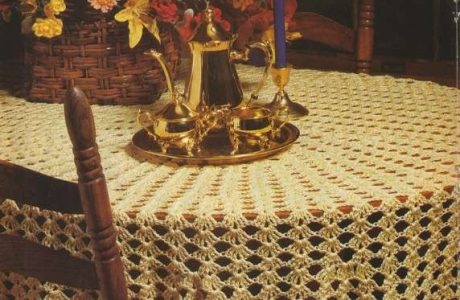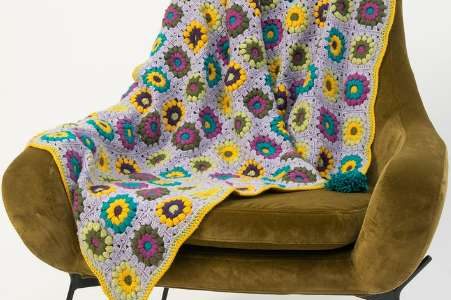
Crochet patterns are often ranked according to some scale of Difficulty Rating. Books, magazines, and websites often use a system to categorize their patterns based on some perceived skill levels. Are these real differences? Are they written in granite? Who decides the difficulty level?
Beginning crochet lessons usually begin with worsted weight yarn and a G or H hook. That seems to be a standard that is commonly used. But, do all crocheters begin with worsted weight yarn? Do some crocheters learn with thread? Is thread more difficult to crochet with? Maybe…
But, let’s say we start with the seemingly universal worsted weight yarn and a G hook. Let’s say we’re all right handed (just pretend, okay?) so there are no issues there. Let’s say we have a good printed reference depicting the basic crochet stitches of chain, single crochet, and slip stitch, and including the starting slip knot. Does this qualify as ‘Easy’? It’s basic, so it’s generally considered to be ‘Easy’.
From there, with practice, we move to Double Crochet, Half Double Crochet, and finishing off. Still pretty basic. Still ‘Easy’? Most would say so. Add more stitches, Treble, Double Treble, etc. Increases, Decreases, Double Crochet Together, changing colors, and on it goes.
And, that’s if you can even READ a crochet pattern. Many expert crocheters have never learned to read a pattern and would scoff at our designations of ‘Easy’ or ‘Challenging’.
So, where does that leave us? Where are the standards for determining the skills needed to successfully complete a given pattern? Do you trust the skill levels that accompany patterns? If not, why not – and how do you decide the pattern is one you could successfully reproduce? If you trust the designated skill level for a given pattern, are you discouraged from attempting it because you have yet to master a particular stitch?
I am not a Master Crocheter. I’ve been crocheting for about 13 years, took a few lessons at the beginning, and have used the good counsel of my friends who crochet more proficiently than I do to help me master new stitches and techniques. Further, I am fairly adventurous and am willing to try new things, so I have learned quite a bit on my own. Still, there are some patterns that I find particularly daunting and will not attempt. Why?
I have tried and tried and cannot seem to master a good Bouillon Stitch. I have attempted filet a number of times and appear to have a real problem with counting. I won’t try new stitches with mohair yarn because it’s a bear to frog. I find myself, again and again, missing something in a pattern, one of those ‘repeat this’ signs or an entire run of stitches and have to frog more than once. My joke is that for every 10 rows, I crochet about 25 rows! That’s how often I must frog when I pick up a new pattern until I figure out the stitch pattern or memorize the darn thing. But, that’s no indication of the difficulty of the pattern. That’s my own inadequacy, my failure to carefully read and count.
But, as to pattern difficulty, I can find few attempts at standardization.
Check out our NEW Facebook page for Crochet. This page is only about Crochet!! Free pattern links, tips tricks and tutorial videos. We will be sharing it all to the ONE SPOT. Make sure you LIKE the new Crochet Facebook Page so you don’t miss out. Crochet Facebook Page.
Check out this amazing book with over 100 different Granny Square patterns
Here’s a paragraph straight from Annie’s Attic regarding ‘Learning to Read a Crochet Pattern’ by Brenda Stratton:
“Most crochet patterns are rated according to level of difficulty, including beginner, easy, intermediate and advanced. Choose the level of difficulty most suited to your crochet abilities. Avoid the frustration in trying to work with a crochet pattern that is too advanced. As you gain more crochet experience, you will be able to successfully tackle more difficult pattern.”
Brenda’s entire article is worth reading, especially for a beginner, and has lots of good reference information. Check it out here . But, in all of the article, she does not define any of the skill levels. Just that you’ll become more skilled the longer you crochet. True? Not necessarily. I have a friend who has crocheted for years, but ONLY crochets square baby blankets using a basic granny pattern. Anything more complicated is too frustrating for her to master. So, she sticks to what she knows.
Further research of crochet pattern sites online produced few insights, and even less definitive categories of skill levels.
On the LionBrand free pattern site, I entered the words ‘Challenging Crochet Pattern’ in the Search box. A single pattern was shown. Here it is:
http://cache.lionbrand.com/faq/451.html
This pattern is listed as Challenging/Complex despite the fact that the stitches used include only chain, single crochet, and half double crochets. Even though I am numerically challenged, this is not a challenging pattern for me. What about you?
On the other hand, Caron lists this pattern as ‘Easy’ (Not Beginner)
and has several paragraphs of stitch information before the pattern begins, including the information that the stitches used are chain, single crochet, and slip stitch. Why is this not a Beginner pattern?
I have made several of these. They are pretty basic and I would not hesitate to suggest this to a rank beginner as a first attempt after those basic stitches are mastered. Why? No shaping, no fancy stitches, forgiving sizing, and no need to change yarn colors. Those are earmarks of a Beginner pattern for me.
For me, thread was a challenge. On the advice of a good friend who provided me with the pattern, I used thread and a G hook to make a baby sweater similar to the Mitered Baby Sweater pictured here. The combination of G hook and size 10 thread proved to my hands and my mind that I, too, could crochet with thread. Since then, I’ve crocheted many projects with thread. Thread alone does not determine the skill level for me any longer. Once it did. Now it does not. One project changed my perception of the skills I needed to crochet with thread.
I have friends with varying attitudes about skill levels. The one thing they all agree on is that if a project is appealing enough, they’ll learn the skills needed to make it. That attitude propels them forward, opening up new vistas in crochet, allowing them to attempt and master most crochet stitches and techniques without much fear. And, fear, after all is what prevents most of us from moving forward with our skills.
All of this said, I do wish there was a Uniform Code of Skill Levels we could use as a guide in determining if a pattern is appropriate for us to attempt – to spend the money on the yarn (or maybe even tools like a Hairpin Lace Loom), to plan extra time to master a new skill set, to encourage us to work thoroughly through each skill level as and when we want/need to. This site comes closest to an all-encompassing definition of crochet skill levels. While I may not agree fully with their descriptions of the skill levels, it’s nice to see a reliable source that has at least attempted to define the terms. Now, to get pattern designers to agree to use these designations!
Want more filet patterns? Check these out on Etsy and these Filet Crochet Patterns books







Thank you for a thoughtful article about something that most of us have wondered about. I, too, have done patterns that I thought the skill label was incorrect. I think I rate projects by their “frustration” level.
Through my only two years of crochet, I rate projects by want to complete. It’s an emotional value that I usually assign to each project whether if it’s a gift or for myself. I choose “easy” patterns to get things done quickly for gifts that are short notice. Other times I choose more “challenging” patterns for when I get the time to really get into a project. Challenging patterns have either small stitches on a small hook, or many different types of stitches.
Also, I will say that I usually change the patterns up from what’s written. If something is supposed to be done with lace weight or crochet thread on a size 7 steel hook…well, I might just switched that up to being a two-strand of worsted on a size L! That’s one pattern and a whole mess of projects!
Anyway, I also have a tendency to challenge myself with tons of hard patterns so my perception might be skewed slightly.
-pat
Pat,
You make quite a few good points. I think you and I share a philosophy about crochet – and especially about the relevance of patterns. They are mostly suggestions!
Thanks for your input.
jd
I have been crocheting for about 30 yrs off and on. For the past probably 20 of those years I try to find stitches that I haven’t made and do a sample of them just to see if I can do them. Sometimes it takes a little practice but eventually they look like they are supposed too. I then find a pattern with those stitches in them and go for it. I also find vintage patterns and try to figure out the different between the patterns then and now. My most recent is an afghan that has about 10 different stitches in it and you have to carry 6 different colors of yarn at a time. That was fun and it turned out beautiful. That is one of the things I feel that make crochet fun.
Sorry for the long post before, but as far as my crochet ranking is, I don’t know because I have had some patterns that almost seem a little over my head. I suppose I would be considered intermediate. But yes, I wish they would have the same description on the skill levels for all companies.
Great article and definitely an issue worthy of some discussion. I noted recently in a crochet magazine that they rate their patterns based on concentration level rather than difficulty. This seemed sensible to me because that is often what will determine the success or desire to do a pattern: how much you will have to focus on it while crocheting.
Level of concentration seems to be the determing factor on how ‘difficult’ a pattern really is. If I have to look at it frequently, or if the pattern repeat is not easily memorized-then to me, it is a difficult pattern. But fun anyway!
I have been crocheting for 20 years. I still find patterns that are intimidating to me. I have found that interpreting the directions is the skill level determiner for me. If the pattern is difficult to read and decipher I put it down and back away slowly. If I am able to decipher it I will pick it up and go for it. I am up for trying new patterns. I have also found that I enjoy crocheting with thread more than yarn. The stitches always stay the same no matter what product you are using. I still have no idea what my skill level is, but does it matter? My philosophy is, “If you like the way it looks, and you enjoy doing it, go for it!” If I like the pattern enough, I will learn it and work through it. There is still alot of things I have yet to learn, but those things keep me intrigued. Like frogging. What is that?
Frogging is what we call ripping out our work. Rip It! Rip It! Kinda like the sound a frog would make. As for your philosophy – Too Right!
jd